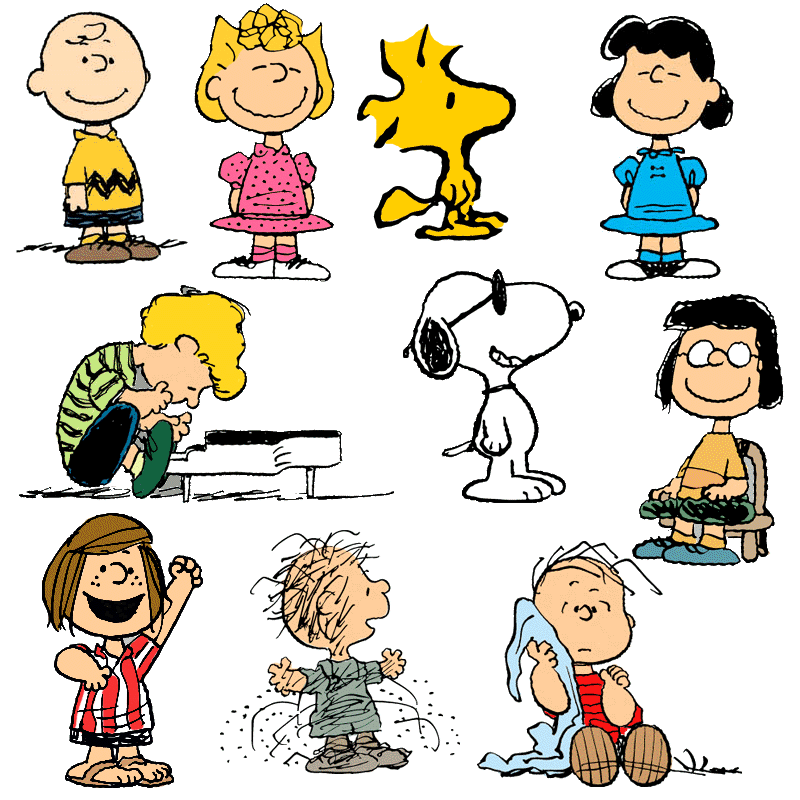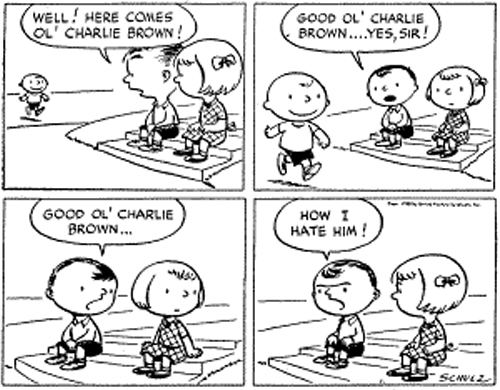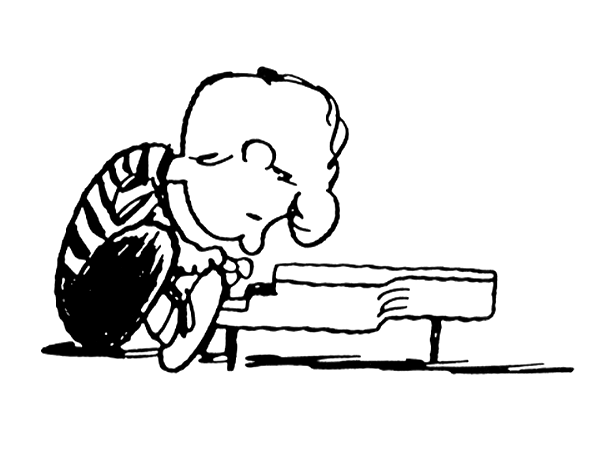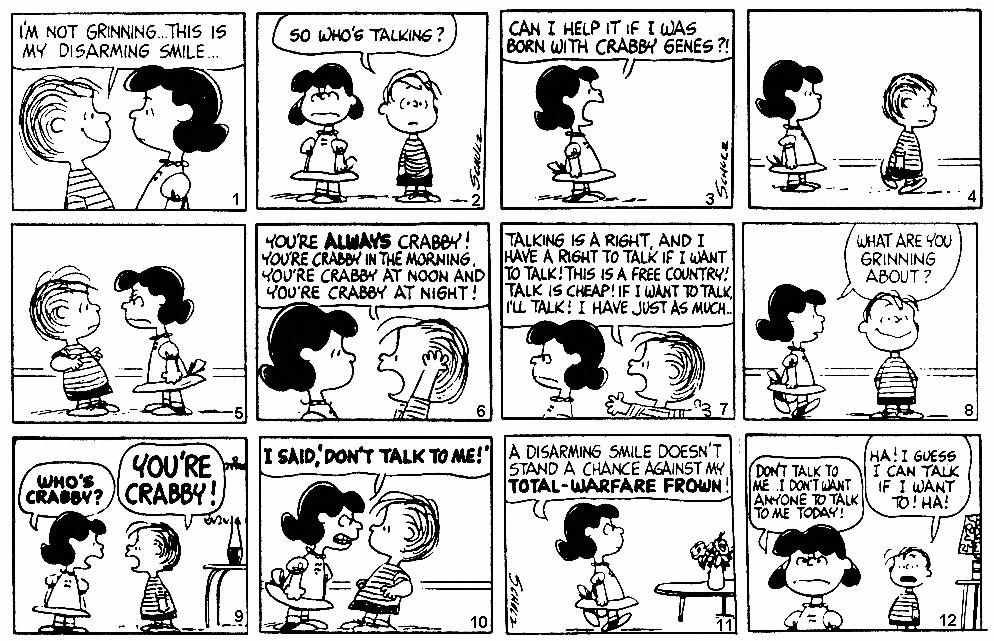Giving Peanuts Texture
How the Peanuts cast evolved from the generic to the special
by Nat GertlerWhen we think of the comic strip Peanuts, we usually dwell on all the characters, their special quirks and relationships. We think of the Linus's need for a security blanket, of Charlie Brown's unrequited love for the Little Red-Haired Girl, of Snoopy's World War I missions, of Lucy's fussbudgetness and of Marcie's presence as a sidekick for the Peppermint Patty, whom she curiously calls "sir.” It is easy to miss the fact that this was not always the case.
The first Peanuts comic strip, Oct. 2, 1950
When the strip started, it featured three kids (Charlie Brown, Shermy, and Patty) and a dog (Snoopy, although a much more dog-like Snoopy than the one we now know.) The kids were basically interchangeable; with the exception of some gender-specific interplay, you could have replaced any one of the kids in a strip with either of the others, and it would not have seemed odd.
Charles Schulz: ‘I was not sure who would become the hero or the heroine. I had trouble deciding because, at the time, Charlie Brown was not the put-upon character that he is now. Eventually I had trouble making Shermy anything but a straight man; Patty and a new girl, Violet, were serving merely as straight women; and Snoopy hadn't started thinking yet—so all the good lines were given to Charlie Brown.’
Charlie Brown soon started to be a bit of a wisecracker. As Schulz himself would note in his book Charlie Brown, Snoopy, and Me (co-written by R. Smith Kiliper) "...I was not sure who would become the hero or the heroine. I had trouble deciding because, at the time, Charlie Brown was not the put-upon character that he is now. Eventually I had trouble making Shermy anything but a straight man; Patty and a new girl, Violet, were serving merely as straight women; and Snoopy hadn't started thinking yet—so all the good lines were given to Charlie Brown." Even so, there were few strips where you couldn't replace Charlie Brown with Shermy.
The introduction of Schroeder changed the status quo…It was the introduction of Schroeder that really changed this status quo. This wasn't because of Schroeder's position as a toy piano prodigy and Beethoven booster, although he would be given those attributes a short while later. Instead, it was due to his being a baby at the time of introduction, and thus being the center of baby jokes and kid-and-baby interaction. At various times over the run of the strip, newly introduced characters such as Linus, Sally, and Rerun would fulfill much the same role until subject to the bizarre system of aging that takes place in Charlie Brown's neighborhood.
When he was given ability to play great classical works on a piano with the black keys just painted on, however, that was a significant step. Where being a baby made him different in current status, being an aficionado of long-haired music made him different in personality. Even if there were other kids his age (or even if he were the age of the other kids, as he apparently became later), he could not be interchanged with them. If Shermy were suddenly playing a piano concerto, it would seem wrong.
Nineteen fifty-two saw the introduction of family into the strip, in the guise of Lucy Van Pelt and her baby brother Linus. Whereas the only family previously in the strip had been mentioned-but-unseen (although sometimes heard) parents and grandparents, suddenly we could see the interaction between siblings. In the Van Pelt family, we see both the true love and the casual cruelty that can exist between brother and sister. Thematically, this was a powerful addition to the strip, and one that still plays well not only between Linus and Lucy, but also between Charlie Brown and Sally (who was born in 1959).
Lucy became crabby, eternally dissatisfied with the world around her; Linus grew up to have an intellectual philosophical bent and a strong sense of faith.The next big change is hard to pinpoint. Where the early established personalities are largely quirks (piano playing or blanket carrying), the characters started to develop their own world views. Lucy became crabby, eternally dissatisfied with the world around her. Charlie Brown's dissatisfaction was aimed more at himself. Linus grew up to have an intellectual philosophical bent and a strong sense of faith. Snoopy became trapped in a world of imagination. It is these things that define the common view of Schulz's work above anything else. This moved the strip from being simply a well-crafted strip to being a great work, one studied not just for its humorous value but for its religious and psychological insight.
At this point, the characters who didn't have notable personalities (Shermy, Violet, and Patty) started to fade into the background. Any new characters introduced had their own place in this world, even if it was only a unique set of quirks: Pig-pen with his anti-sanitary status, Frieda with her naturally curly hair, boneless cat, and desire to see rabbits chased, or 5 with his numerically-oriented family.
But that wasn't the end of the growth in Schulz's work. At this point, the strips was still set in a single neighborhood, a white, Christian, middle-class suburban environment. However, we did get another part of town starting with the introduction of Patricia "Peppermint Patty" Reichardt in 1966. There didn't seem to be any intent to really start dealing with anything different at first. Schulz writes that he created Peppermint Patty "because I needed somebody from another neighborhood to head up a team that would challenge Charlie Brown's baseball team." However, this other side of the never-quite-named-in-the-strip town would soon show a personality all its own.
As we begin to meet the people from the area, we find that it is a multiracial neighborhood, including Franklin (the first black member of the Peanuts cast) and Jose Peterson (half Mexican, half Swedish). We also begin to notice that some of the residents have personalities that go beyond quirky and come into the range of showing serious problems. Peppermint Patty has severe problems not only learning, but simply staying awake in class; these may be linked to the difficulties of being raised without a mother. Thibault is a vicious bully. (Marcie's calling Peppermint Patty "Sir" likely falls more into the category of a quirk.) We can conclude that this is a lower-income area of town, and probably an overall rougher place to live (although, if Peppermint Patty and Marcie's wanderings are any indication, it still has some nice wooded areas that one can get away in.)
There are two other settings that have been introduced in the strip. One, summer camp (and it's not clear how many camps there are), gives our lead characters the chance to have brief meetings with new people, sometimes having a lasting emotional impact. It's also good for simply getting the characters outside of the settings where they feel comfortable.
The other setting is Needles, California, the desert area where Spike lives. In many ways, this goes beyond giving the strip a different setting; to a large degree, the desert strips are a complete different series. It's a series where there is only one character, living with himself, interacting directly only with cacti.
So over the years, the cast of Peanuts has grown, as has the size of their world, the depth of their characters, the complexity of their relationships, and both Schulz's creative reach and grasp. However, despite that, the core of the strip has remained. It is still about a group of friends. Now, though, they're not just friends with each other, they're our friends as well.
This article was published in issue 1254 of The Comics Buyer's Guide, a journal of the comic book field, and is available online at aaugh.com (http://www.aaugh.com/guide/texture.htm), “Your source for Peanuts books and the works of Charles M. Schulz.”
Founder/Publisher/Editor: David McGee
Contributing Editors: Billy Altman, Laura Fissinger, Christopher Hill, Derk Richardson
Logo Design: John Mendelsohn (www.johnmendelsohn.com)
Website Design: Kieran McGee (www.kieranmcgee.com)
Staff Photographers: Audrey Harrod (Louisville, KY; www.flickr.com/audreyharrod), Alicia Zappier (New York)
E-mail: thebluegrassspecial@gmail.com
Mailing Address: David McGee, 201 W. 85 St.—5B, New York, NY 10024









